Archived Article Detail
By Thomas P. Moore
Need to search for a keyword, title or article on this page? On your keyboard, hold down the “Ctrl” and “F” key and a “Find in page” box will appear at the bottom of your screen. Type in your keyword and check the “Highlight All” box and like magic your keyword will appear highlighted as you scroll up and down the page!
WHAT’S NEW IN THE MINERAL WORLD ARCHIVE – posted on 10/27/2006
We are past the 2006 Ste.-Marie-aux-Mines and Denver shows, and in a couple of weeks I will have to board my flight to Munich (the airlines these days make you show up really early), and so it seems a good time to post a miscellany of news bulletins having to do with What’s New In The Mineral World.
What’s New in Mineral Discoveries
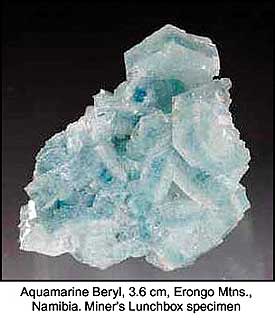 Subscribers by now will have seen the September-October 2006 issue of the Mineralogical Record, with its omnibus article by Bruce Cairncross and Ulrich Bahmann on the minerals of the Erongo Mountains, Damaraland, Namibia. And even if you are only a sometime showgoer who has not seen the article you’ll be aware that since 1999 this 30 km-wide igneous upland in central Namibia has been amazingly lavish in its supplies of aquamarine beryl: the article features 15 full pages of photographs of spectacular beryl (primarily though not entirely aquamarine) specimens from Erongo. The text describes finds as late as January 2006, but it seems it’s already time for an update, for at the 2006 Ste.-Marie-aux-Mines show, Scott Werschky of Miner’s Lunchbox (www.minerslunchbox.com) picked up some small miniature-size specimens manifesting yet another distinct style of aquamarine from Erongo, and a few of these are available on his website. Very sharp, lustrous, short-prismatic to tabular beryl crystals to about 1.5 cm across form loose clusters or attach singly to bits of white (orthoclase?) matrix. The crystals are translucent to transparent and show strong color-zoning parallel to the big c face, with blue central zones and very pale blue-white zones sandwiching them. The crisp little groups of tabular, color-zoned crystals do not resemble any beryl specimens that I have seen before from anywhere else—not even from Erongo.
Subscribers by now will have seen the September-October 2006 issue of the Mineralogical Record, with its omnibus article by Bruce Cairncross and Ulrich Bahmann on the minerals of the Erongo Mountains, Damaraland, Namibia. And even if you are only a sometime showgoer who has not seen the article you’ll be aware that since 1999 this 30 km-wide igneous upland in central Namibia has been amazingly lavish in its supplies of aquamarine beryl: the article features 15 full pages of photographs of spectacular beryl (primarily though not entirely aquamarine) specimens from Erongo. The text describes finds as late as January 2006, but it seems it’s already time for an update, for at the 2006 Ste.-Marie-aux-Mines show, Scott Werschky of Miner’s Lunchbox (www.minerslunchbox.com) picked up some small miniature-size specimens manifesting yet another distinct style of aquamarine from Erongo, and a few of these are available on his website. Very sharp, lustrous, short-prismatic to tabular beryl crystals to about 1.5 cm across form loose clusters or attach singly to bits of white (orthoclase?) matrix. The crystals are translucent to transparent and show strong color-zoning parallel to the big c face, with blue central zones and very pale blue-white zones sandwiching them. The crisp little groups of tabular, color-zoned crystals do not resemble any beryl specimens that I have seen before from anywhere else—not even from Erongo.
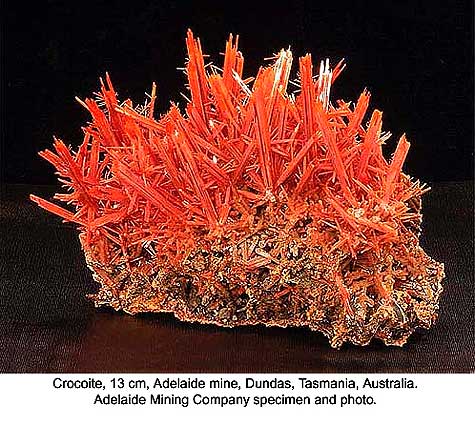 Back in 2005, in one of the earliest installments of this web column, I passed on news that the famous Adelaide mine in Tasmania had undergone a change of ownership and that The Adelaide Mining Company Pty. Ltd. was then optimistically beginning underground work with the idea of recovering specimens of crocoite and whatever-else. Adam Wright, who runs the project (and its website: www.theadelaidemine.com), now informs me that in April 2006, Richard Wolfe, a miner in his employ, broke into a crocoite treasure-trove which the company has since named the Premier Pocket—a vertically oriented void in “limonite”/gibbsite gossan which was richly crisscrossed by crocoite crystals (see the picture, in which the juicy opening is about 50 cm wide). Subsequent very careful collecting produced about 200 crocoite specimens of superior quality, ranging from loose, terminated thumbnail prisms to large cabinet-size pieces with stalk-like crystals flaring up in all directions from earthy brown, gibbsite-coated matrix. This is by far the largest lot of crocoite to come on the market in living memory. The crocoite seems to be more orange than red (although the photos on the website may be a bit overexposed), and some crystals show partial, preferential coatings of gibbsite. Some crystals are hoppered and some have frayed ends, but many show solid, highly lustrous terminal faces. A healthy selection of Premier Pocket crocoite specimens is offered on the website, and more, Adam says, will be brought to the 2007 Tucson Show.
Back in 2005, in one of the earliest installments of this web column, I passed on news that the famous Adelaide mine in Tasmania had undergone a change of ownership and that The Adelaide Mining Company Pty. Ltd. was then optimistically beginning underground work with the idea of recovering specimens of crocoite and whatever-else. Adam Wright, who runs the project (and its website: www.theadelaidemine.com), now informs me that in April 2006, Richard Wolfe, a miner in his employ, broke into a crocoite treasure-trove which the company has since named the Premier Pocket—a vertically oriented void in “limonite”/gibbsite gossan which was richly crisscrossed by crocoite crystals (see the picture, in which the juicy opening is about 50 cm wide). Subsequent very careful collecting produced about 200 crocoite specimens of superior quality, ranging from loose, terminated thumbnail prisms to large cabinet-size pieces with stalk-like crystals flaring up in all directions from earthy brown, gibbsite-coated matrix. This is by far the largest lot of crocoite to come on the market in living memory. The crocoite seems to be more orange than red (although the photos on the website may be a bit overexposed), and some crystals show partial, preferential coatings of gibbsite. Some crystals are hoppered and some have frayed ends, but many show solid, highly lustrous terminal faces. A healthy selection of Premier Pocket crocoite specimens is offered on the website, and more, Adam says, will be brought to the 2007 Tucson Show.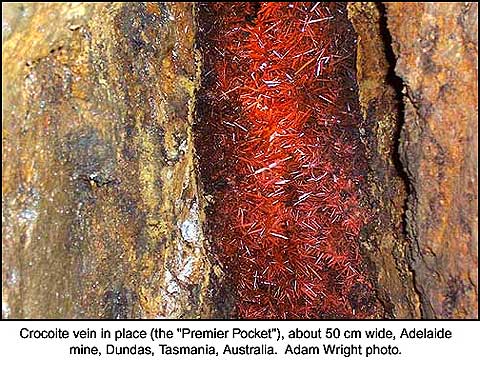
Several venerable silver-mining districts in Mexico excel in lustrous dendritic specimens, but wire silver from Mexican sources has always been very rare. Hence Andy Seibel (www.andyseibel.com) lucked out in acquiring recently about 50 small (thumbnail and miniature) specimens which are simple, loose, gracefully curving and curling wires of bright silver that could indeed be from one of several older places—the Bulldog mine, Colorado; Silver Islet, Ontario; the ancient mines of Freiberg or Andreasberg, Germany—but are instead attributed to a new Mexican locality called Mina Cefada, Guanajuato. Even though, according to Andy, some of the “matrix” pieces that came in this lot were glue jobs, we probably should be taking a (healthily skeptical) interest in the occurrence. 
In the September-October 2006 issue, caboosed onto the end of the huge Erongo article aforementioned, is my report on the 2006 Ste.-Marie-aux-Mines Show, and on p. 478 you will find a paragraph about this spring’s discovery of world-class ferrierite specimens in the Monastir quarry on Monte Olladri, near Cagliari, Sardinia, Italy. Bright red-orange, smooth-surfaced spheres, reaching 2.5 cm in diameter, of the rare zeolite adorn seams and crannies in dark basalt. The same dealer who offered specimens at Ste.-Marie, Giovanni Signorelli of The Webmineralshop, is offering more on the web (www.webmineralshop.com; also www.smartminerals.com), and again I enthusiastically recommend them. Also shown on the website (I do not remember whether I saw any firsthand at Ste.-Marie) are some splendid analcime specimens from a very recent find in the Monastir quarry. Here we have sharp, lustrous, trapezohedral crystals of analcime to 2 cm, milky white to colorless and transparent, resting individually or in intergrown groups on dark matrix pieces to cabinet size. To judge from their pictures, these specimens compare well with analcimes from just about anywhere else—the large, chiseled-looking, snow-white crystals from Mont Ste.-Hilaire possibly excepted.
Remaining with matters Italian for one more paragraph, here’s recommending a leisurely browse through Alessandro Genazzani’s extensive Italian Minerals site (www.ItalianMinerals.com), where about 10 pages of specimens from the famed Isle of Elba are now on view. Most of these are products of recent collecting in the Monte Capanne pegmatites of the western half of the island, and no, they are not of the topmost specimen quality which Elba has produced, but many are very nice. Elbaite, of course, is among the minerals pictured, mostly as dark-hued, translucent prismatic crystals to several centimeters long, either in flat-lying sprays or standing up singly on clean, white, blocky feldspar crystals. There are also generous numbers of “representative” to very good Elba specimens showing smallish crystals of spessartine, beryl, cassiterite, petalite and other species. (Brief yourself for all this by reviewing the beautiful Lapis English #8 booklet on Elba, published last year and available through the Bookstore section of this website.) The Italian Minerals site also offers some interesting things from Madagascar, including excellent liddicoatite crystals on matrix; fine Chinese babingtonites; and some vivid specimens of the brand new pink/red variscite, as microcrystal druses and spheres with strengite and phosphosiderite, from the phosphate pegmatite at the Boa Vista mine, Minas Gerais, Brazil (this variscite also is mentioned in my Ste.-Marie-aux-Mines Show report).
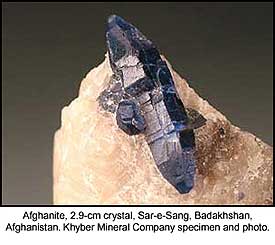 “Lapis lazuli,” an attractive mixture of calcite, pyrite and lazurite, has been known from Afghanistan for the last 6000 years or so—admired for its resemblance to a night sky with clouds and starts—and euhedral lazurite crystals were probably found there, together with the prized deep blue massive material, at least as far back as the time of Alexander the Great. However, it is only in recent years that the mineral-collecting world has learned of the euhedral crystals of sodalite, winchite, cancrinite, afghanite and other much rarer species which, like the lazurite crystals, are found embedded in white marble at a locality (or localities) most often given as the Sar-e-Sang mine, Badakhshan, Afghanistan. Notable crystals of afghanite from Sar-e-Sang began to appear in the West in 2001, and at each show since then one’s peripheral vision has seemed to register specimens which collectively are creeping upwards along the quality scale. Afghan afghanite crystals at their best are richly deep blue, elongated, slightly edge-rounded hexagonal prisms with pyramidal terminations; the most elite are actually translucent along some edges, or very rarely, especially near the terminal points, show gemmy patches. This past August the Khyber Mineral Company (www.khyberminerals.com) bought 12 fine afghanite specimens from a miner in Pakistan who had stored them away since 2001. These show sharp, doubly terminated afghanite crystals to 3 cm on pieces of white marble matrix from 3 to 6 cm across. It is an unusually large stash of specimens of this exotic species, which effectively did not exist in collector specimens as recently as ten years ago.
“Lapis lazuli,” an attractive mixture of calcite, pyrite and lazurite, has been known from Afghanistan for the last 6000 years or so—admired for its resemblance to a night sky with clouds and starts—and euhedral lazurite crystals were probably found there, together with the prized deep blue massive material, at least as far back as the time of Alexander the Great. However, it is only in recent years that the mineral-collecting world has learned of the euhedral crystals of sodalite, winchite, cancrinite, afghanite and other much rarer species which, like the lazurite crystals, are found embedded in white marble at a locality (or localities) most often given as the Sar-e-Sang mine, Badakhshan, Afghanistan. Notable crystals of afghanite from Sar-e-Sang began to appear in the West in 2001, and at each show since then one’s peripheral vision has seemed to register specimens which collectively are creeping upwards along the quality scale. Afghan afghanite crystals at their best are richly deep blue, elongated, slightly edge-rounded hexagonal prisms with pyramidal terminations; the most elite are actually translucent along some edges, or very rarely, especially near the terminal points, show gemmy patches. This past August the Khyber Mineral Company (www.khyberminerals.com) bought 12 fine afghanite specimens from a miner in Pakistan who had stored them away since 2001. These show sharp, doubly terminated afghanite crystals to 3 cm on pieces of white marble matrix from 3 to 6 cm across. It is an unusually large stash of specimens of this exotic species, which effectively did not exist in collector specimens as recently as ten years ago.
Also notable on the Khyber Mineral Company site are a few superb, thumbnail-size specimens of “chondrodite” such as have been coming recently from Ladjuar Madan, Kokcha Valley, Afghanistan. The specimens show gemmy, lustrous, complex red-brown crystals to 2 cm on matrix with clinochlore, and the best of them come in at between $100 and $200, making them major bargains in light of the pricing of this material at major shows lately. I mention them here, however, also because a reminder seems in order: the species has been shown to be clinohumite, not chondrodite, and too many dealers, both on the web and at shows, have yet to get, or have chosen to ignore, that intelligence, which first began to get around at the 2006 Tucson Show (see that report in the May-June 2006 issue).
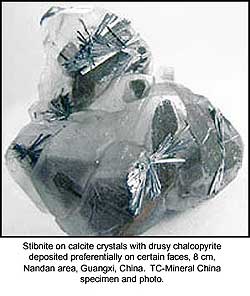 Mr. Weigang Chen of Xiamen, Fujian Province, China has had a website since 1997, and I have mentioned it once before but will do so again, as it’s getting more interesting all the time. Mr. Chen’s mineral shop is called Tianci Mineral Crystal World and its web presence, called TC-Mineral-China, may be accessed at either www.china-mineral.cn or www.mineral-china.cn. One of the first things you’ll see here is an array of photos of Mr. Chen’s very own spessartine mine near Tongbei, Fujian, very actively operating, and then comes page after page of Chinese minerals familiar and strange, as specimens varying widely in size, quality, and every other parameter you can think of, but generally offered at prices lower than those asked at Western shows by Western or Chinese dealers. The slow loading speed of the pages can be frustrating, and the small size of the pictures can make the true quality and Gestalt of the specimens hard to judge, but except for those drawbacks (common to many websites), making one’s way through these many pages is a time-devouring delight. When I last looked in I saw good specimens of the new acanthite/silver from the Hongda mine, Lingqui, Shanxi; orange barite as gemmy tabular crystals resting on green fluorite from the Xiefang mine, Jiangxi; red sphalerite crystals to more than 2 cm on drusy quartz coatings on matrix plates to 14 cm across, from the Shuikoushan mine, Hunan; sharp, transparent-colorless apophyllite crystals in stegosaurid rows along the faces of quartz prisms, from the Daye mining area, Hubei; recently mined realgar from the Shimen mine, Hunan; and more things which may plausibly be called “familiar.” More interesting, of course, are those things which may plausibly be called “unfamiliar,” and calling for—well, why not a new paragraph altogether?
Mr. Weigang Chen of Xiamen, Fujian Province, China has had a website since 1997, and I have mentioned it once before but will do so again, as it’s getting more interesting all the time. Mr. Chen’s mineral shop is called Tianci Mineral Crystal World and its web presence, called TC-Mineral-China, may be accessed at either www.china-mineral.cn or www.mineral-china.cn. One of the first things you’ll see here is an array of photos of Mr. Chen’s very own spessartine mine near Tongbei, Fujian, very actively operating, and then comes page after page of Chinese minerals familiar and strange, as specimens varying widely in size, quality, and every other parameter you can think of, but generally offered at prices lower than those asked at Western shows by Western or Chinese dealers. The slow loading speed of the pages can be frustrating, and the small size of the pictures can make the true quality and Gestalt of the specimens hard to judge, but except for those drawbacks (common to many websites), making one’s way through these many pages is a time-devouring delight. When I last looked in I saw good specimens of the new acanthite/silver from the Hongda mine, Lingqui, Shanxi; orange barite as gemmy tabular crystals resting on green fluorite from the Xiefang mine, Jiangxi; red sphalerite crystals to more than 2 cm on drusy quartz coatings on matrix plates to 14 cm across, from the Shuikoushan mine, Hunan; sharp, transparent-colorless apophyllite crystals in stegosaurid rows along the faces of quartz prisms, from the Daye mining area, Hubei; recently mined realgar from the Shimen mine, Hunan; and more things which may plausibly be called “familiar.” More interesting, of course, are those things which may plausibly be called “unfamiliar,” and calling for—well, why not a new paragraph altogether? 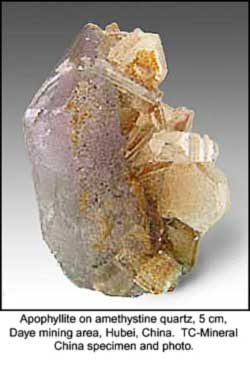
The Nandan mining area, Nandan County, Guangxi, is producing unusual specimens of calcite/chalcopyrite/stibnite: clusters of milky white to transparent and colorless, modified-rhombohedral calcite crystals whose edges are sharply outlined by oriented drusy coatings of chalcopyrite, with small sprays of stibnite scattered irregularly on the surfaces of the calcite crystals; attractive, matrixless crystal clusters reach 12 cm across (Rob Lavinsky is showing a handful of these specimens on his Arkenstone website too). Also from Nandan comes axinite (species unspecified), as lustrous, dark brown, in a few cases gemmy, unusually thick crystals to 2 cm individually, these forming subparallel groups on quartz crystal clusters to more than 11 cm across. A few specimens of this material showed up in Denver in 2005, at which time the locality was conjectural, with one dealer giving Nandan, Guangxi while another gave Mian Ning, Sichuan…Mr. Chen’s site says that the specimens he offers are from a find in summer 2005, and that they come indeed from Nandan, where more have not been unearthed since that time. Also from Nandan there have come modest specimens of adamite in pale yellow crystal sheaves on “limonite” matrix, looking exactly like Ojuela mine, Mexico specimens. And finally, as Mr. Chen writes it in his web text, “on 2006-09-10, when I travel to Daye [i.e. the Daye mining area in Hubei, famous for inesite, apophyllite, hubeite etc.], my friend just found this little vug [with] about 80 pieces” showing sharp, yellow-brown, translucent bowtie-aggregates of stilbite to 4 cm on matrix with chalcopyrite and epidote crystals.
 There is one more bit of news from China, courtesy this time of Steve Behling of Collector’s Edge (steve@collectorsedge.com)– a dealership which has by no means been slouching lately when it has come to procuring fine Chinese minerals. In our upcoming “China II” special issue you will find a short article by Berthold Ottens about the Chengmenshan copper mine, Jiujiang Prefecture, Jiangxi Province, from which have come fine specimens of azurite, malachite, and the acicular “chalcotrichite” variety of cuprite. Of native copper from Chengmenshan, however, Ottens writes only that “modestly good” dendritic specimens were found in 2003-2004, and that distinct copper crystals from the locality reach only a few millimeters. But Collector’s Edge has just taken in two exceptional, brightly lustrous and coppery-colored, cabinet-size Chengmenshan copper specimens which show individual euhedral crystals to 1 cm. The specimen pictured here measures 6 x 13 cm, and speaks well (to put it mildly) for the future promise of the locality.
There is one more bit of news from China, courtesy this time of Steve Behling of Collector’s Edge (steve@collectorsedge.com)– a dealership which has by no means been slouching lately when it has come to procuring fine Chinese minerals. In our upcoming “China II” special issue you will find a short article by Berthold Ottens about the Chengmenshan copper mine, Jiujiang Prefecture, Jiangxi Province, from which have come fine specimens of azurite, malachite, and the acicular “chalcotrichite” variety of cuprite. Of native copper from Chengmenshan, however, Ottens writes only that “modestly good” dendritic specimens were found in 2003-2004, and that distinct copper crystals from the locality reach only a few millimeters. But Collector’s Edge has just taken in two exceptional, brightly lustrous and coppery-colored, cabinet-size Chengmenshan copper specimens which show individual euhedral crystals to 1 cm. The specimen pictured here measures 6 x 13 cm, and speaks well (to put it mildly) for the future promise of the locality.
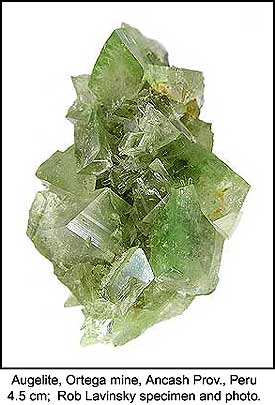 Besides the Erongo aquamarines described earlier, the Miner’s Lunchbox site (www.minerslunchbox.com) is offering a dozen or so of the very new, small-but-superb specimens of Peruvian augelite mentioned in the preceding installment of this web column; Rob Lavinsky’s Arkenstone (www.irocks.com) pictures a smaller number of premium specimens of the material. At the end of June, as you may recall, I mentioned these specimens as seen on an Italian dealer’s website, from whence came the picture of the excellent thumbnail which I showed then. Meanwhile, back in Texas, Rob Lavinsky had already reserved some specimens—wonderful miniature-size augelite and augelite/quartz crystal clusters– which you may still see on his site but most of which by now have found new and loving homes. Scott Werschky of Miner’s Lunchbox picked up his stash of Peruvian augelites by a lucky chance at the Ste.-Marie-aux-Mines Show in June, and also picked up some new information about the occurrence, which I here pass on. Two brothers from Lima, the Ortega brothers, obtained a concession to dig quartz crystals in an abandoned mine (whose original name has not yet been revealed) just north of the famous Huanzala mine, in Ancash Department. The Ortegas merely wanted to obtain quartz for use as bases for stone bird carvings, but instead they came upon several hundred green crystals and crystal clusters, the best of which turned out to be the finest augelite specimens ever unearthed anywhere. Between 200 and 300 specimens of varying quality and varying degrees of damage came out, and the Ortega brothers now hope to mine more from their claim, which they have named the Mina Ortega; however, they may decide that they cannot afford the necessary investment. Thus the few specimens now available may—or may not—represent all that the market will ever see. So you might as well check out the picture here closely: these are gorgeously lustrous and sharp and transparent, pale green augelite crystals to 2.5 cm individually, and when they form loose clusters with colorless prisms of quartz the aesthetics are stunning.
Besides the Erongo aquamarines described earlier, the Miner’s Lunchbox site (www.minerslunchbox.com) is offering a dozen or so of the very new, small-but-superb specimens of Peruvian augelite mentioned in the preceding installment of this web column; Rob Lavinsky’s Arkenstone (www.irocks.com) pictures a smaller number of premium specimens of the material. At the end of June, as you may recall, I mentioned these specimens as seen on an Italian dealer’s website, from whence came the picture of the excellent thumbnail which I showed then. Meanwhile, back in Texas, Rob Lavinsky had already reserved some specimens—wonderful miniature-size augelite and augelite/quartz crystal clusters– which you may still see on his site but most of which by now have found new and loving homes. Scott Werschky of Miner’s Lunchbox picked up his stash of Peruvian augelites by a lucky chance at the Ste.-Marie-aux-Mines Show in June, and also picked up some new information about the occurrence, which I here pass on. Two brothers from Lima, the Ortega brothers, obtained a concession to dig quartz crystals in an abandoned mine (whose original name has not yet been revealed) just north of the famous Huanzala mine, in Ancash Department. The Ortegas merely wanted to obtain quartz for use as bases for stone bird carvings, but instead they came upon several hundred green crystals and crystal clusters, the best of which turned out to be the finest augelite specimens ever unearthed anywhere. Between 200 and 300 specimens of varying quality and varying degrees of damage came out, and the Ortega brothers now hope to mine more from their claim, which they have named the Mina Ortega; however, they may decide that they cannot afford the necessary investment. Thus the few specimens now available may—or may not—represent all that the market will ever see. So you might as well check out the picture here closely: these are gorgeously lustrous and sharp and transparent, pale green augelite crystals to 2.5 cm individually, and when they form loose clusters with colorless prisms of quartz the aesthetics are stunning.
The first known gem-quality elbaite crystals found in the United States were picked from the soil by a couple of boys in 1820 at Mt. Mica, Oxford County, Maine, and this classic locality continued intermittently to produce specimens until the 1970’s. Since July 2003 Mt. Mica has been enjoying a major revival, once more producing fine green, pink and color-zoned elbaite crystals, as well as significant specimens of other pegmatitic species—the renaissance was one of the major stories of the 2005 Tucson Show, when a case of spectacular, recently collected specimens was put on view in the Convention Center, while hundreds of newly dug Mt. Mica elbaite crystals were being sold off by Graeber & Himes just across the aisle. Activity at Mt. Mica is still going on. Gary and Mary Freeman own the site, and also own Coromoto Minerals, LLC, which conducts specimen-digging operations, with Gary Freeman and Richard Edwards as the chief miners (read about it at www.coromotominerals.com). On September 13 of this year a huge pocket was entered along what Gary believes to be an extension of the “classical” tourmaline-producing zone; it is called MMP21-06, as it is the 21st pocket discovered in 2006. The pocket is 4 meters long and consists of four discrete chambers, all containing crystals of gemmy green elbaite and smoky quartz, but the most exciting discovery, and a real what’s-new for Mt. Mica, are a few large specimens in which parallel groups of bright pink rose quartz crystals form long, undulating ridges and rills encircling stout smoky quartz prisms. The specimens resemble some from Lavra Berilo Branco, Brazil (see Wendell Wilson’s article in vol. 30, no. 5), and also suggest greatly magnified versions of those which came from Paroon, Afghanistan in 2002 (see the Tucson Show report in vol. 33, no 3), except that the Mt. Mica specimens show associated elbaite and lepidolite, as Berilo Branco and Paroon specimens do not. One enormous specimen of rose quartz crystals on smoky quartz has a shape suggesting that of an aircraft carrier, and has been named the “Yorktown” after the American carrier which surprised the Japanese fleet to win the Battle of Midway—Gary Freeman explains that these rose quartz specimens represent “Maine’s surprise attack on Brazil.” Let us hope that the battle continues, with vigorous fighting; we’d be glad to take in casualties and refugees. 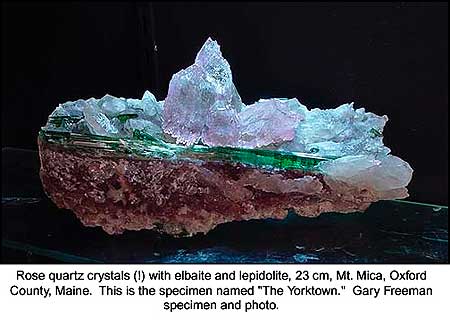
What Else is New
Now for a bit of “old” news from several months ago, concerning specimens which are considerably older still. In vol. 15, no. 1 (Jan.-Feb. 1984) of the Mineralogical Record there is a thorough article by C.S. Stolburg called “The mines and minerals of Darwin, California,” informing us that this old polymetallic mining district in Inyo County shut down commercially in the late 1970’s, and that its best known specimens are those showing sharp (though always a bit distorted), opaque bluish gray, pseudo-octahedral crystals of “scheelite” topping out at about 2 cm. The “scheelite” specimens, often seen in older collections, were found for decades throughout the district, but probably the best are those which came from the Thompson mine, which ceased operations in 1976. It now turns out that these are not scheelite crystals after all, but something much more intriguing: determinative work done earlier this year at the Mackay School of Mines of the University of Nevada on a batch of old specimens has shown that all of the specimens—all of them in the tested batch, anyway—are stolzite pseudomorphs after scheelite. Since the appearance of all of the “scheelite” crystals on the old Darwin specimens is very much the same, it’s at least quite plausible that all are actually stolzite pseudomorphs; these must therefore be counted as among the world’s finest stolzites (if you do not hold the pseudomorphism against them), and such is your consolation for having to change your labels. Thanks to Scott Werschky of Miner’s Lunchbox for this information; you may see his bulletin about the matter, plus a picture or two (though no more samples for sale, alas) at www.minerslunchbox.com. 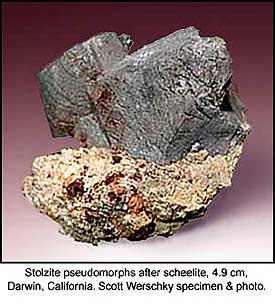
Next, a quick correction. In my print report on the 2006 Tucson Show (May-June 2006 issue), I mentioned some fairly respectable gold specimens from Peru which I saw at one of the hotel shows along I-10 on the west side of town. Repeating the dealer’s information, I said that the locality was the Lily copper mine, Pisco Province, Ica Department (famous for its colorless gypsum crystals enclosing bright green atacamite and other secondary copper species). No, says Peru expert Jaroslav Hryšl, the true locality for the gold is Pampa San Jose, Carolita, Huancay (see the Peru Update article by Hyršl and Rosales in vol. 34, no. 3)…it is just that the dealer in question has developed the habit of calling ALL of the mines in which he has interests “the Lily mine.” If you can think of a moral, or at least a punchline, you are welcome to it.
In Denver this September, Bryan Lees and I had, as has become our custom, a “what’s-new lunch” in the cafeteria at the Main Show, and I got to hear about new projects being undertaken by the ever-questing Collector’s Edge dealership and specimen-mining company. For one, the company’s long-running benitoite-mining project at the famous Benitoite Gem mine in California has finally run its course: “commercial” mining has ceased, probably for good. There remain many tons of material on which the lab wizards of Collector’s Edge will work slowly, perfecting their art of rescuing first-class benitoite and neptunite specimens from enclosing natrolite veins, and so these specimens ought to continue trickling out for awhile. The deposit itself has been sold to Dave Schreiner, who intends to make it a “collecting park,” i.e. a fee-digging site, where private collectors presumably will go on finding superb benitoite/neptunite specimens—or at least the pre-processing makings of them—for many years.
As mentioned in my 2006 Denver Show report (Nov.-Dec. 2006), Bryan’s two most exciting new projects involve (1) the famous granite pegmatite of Mt. Antero, Colorado, with its aquamarine, and (2) the mysterious new rhodochrosite locality in China, sometimes called the Babu mine but (Bryan says) more correctly called the Wuzhou mine, Guangxi Province. As to (1), serious mining is underway on Mt. Antero to try to locate more fabulous pockets of aquamarine like the one whose great matrix specimens dazzled Tucson showgoers in 2005—and already fine thumbnails with individual crystals of phenakite reaching 2.5 cm are coming out. As to (2), well, the strong resemblance between the rhodochrosites of Guangxi and those of the Sweet Home mine has already been widely noted, especially in cases where crystals of purple fluorite, black sphalerite and colorless “needle” quartz accompany the bright pink rhodochrosite rhombs and lenticular crystals in the Chinese material. (It should immediately be noted that the quality of the Chinese specimens so far stops a light-year or two short of the quality of the best from Sweet Home.) The locality now, Bryan says, is a marginally viable polymetallic mine, and soon the vulgarian ore merchants may very well go away, thus leaving a clear field for a specimen-mining operation of Bryan’s like the one he conducted at Sweet Home. In this place I will note a small lot of “Wuzhou” rhodochrosite specimens from “a small find of a few months ago” which Rob Lavinsky has put up on his Arkenstone site: miniatures, from about 3 to 6.5 cm, consisting of glowing pink-red lenticular crystals, a few with adhering albite. Rob was told that only about 100 good specimens of this style were found, and these (for the record) do not look like Sweet Home mine rhodochrosite. 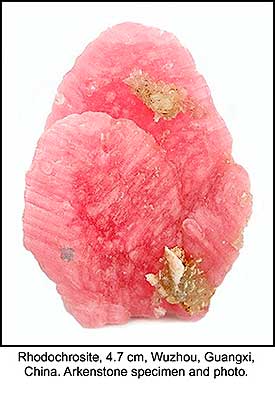
It gives me major pleasure to report a bit of personnel news, too, from Collector’s Edge. Denver resident Tom Gressman, a longtime member and past president of the Mineralogical Record Board of Directors and an ace thumbnail collector as well, has recently left his old job in the great gray field of finance in order to become the newest employee of Collector’s Edge, where he will handle business affairs, work on the website, assist at shows, and just generally, you know, Play With Rocks in constructive ways. Tom’s short biography has just been posted to the Label Archive on this website: www.mineralogicalrecord.com/labels.asp?colid=677&submitmineral.x=76&submitmineral.y=6. Congratulations to a good friend (though you know, Tom, I ‘m still waiting to hear from you about that Freiberg galena thumbnail…).
Last of all—there’s a “Natural History sale” in Los Angeles in December, including a gold nugget auction and a Bisbee specimen auction. The firm of Bonhams & Butterfields, an occasional advertiser in our magazine, will be starting proceedings at noon on Sunday December 3, at Bonhams & Butterfields, 7601 Sunset Boulevard, Los Angeles, CA 90046 (address inquiries to Thomas Lindgren and Claudia Florian, G.J.G, naturalhistory.us@bonhams.com). The gold nugget collection consists of 32 nuggets (the largest weighing 21.61 oz.) assembled by Alaskan businessman and entrepreneur Arthur J. Sexauer. The collection was held by the University of Alaska Mineral Museum from 1973 to 1979, when it was purchased by Las Vegas hotel impresario Steve Wynn, who arranged for its display at the Golden Nugget Hotel and Casino, where for more than 25 years the nuggets have been a major Las Vegas tourist draw. They are bright and vari-shaped, and of course they must evoke the allure of the wild placer streams and snowy wastes of the catastro-comic-chaotic Yukon Gold Rush of the turn of the 20th century. 
The Bisbee collection which also will go on auction on December 3 is a group of very large azurite, azurite/malachite, and “velvet” malachite specimens from the earliest days at mining at Bisbee, i.e. the 1880’s, and includes also some early Morenci, Arizona material. Containing nearly 700 pieces in all, the collection was shown at the Columbian Exposition at Chicago in 1893, then purchased by wealthy oilman Levi Smith of Warren, Pennsylvania, who donated it to the local high school there; afterwards it spent 50 years on display at the Earth & Mineral Sciences Museum of Penn State University. Auction previews for this and for the gold nugget collection will open to the public on Friday, December 1 and continue daily from 10:00 a.m.. to 5:00 p.m. until the start of the auction. The illustrated catalog will be available online (www.bonhams.com/us) until the auction begins. 
A Final News Flash
As I revise this report on October 27, exciting news of a major museum collection sale is just beginning to break: you will read about it in Wendell Wilson’s editorial in our November-December 2006 issue, and even now you may read that editorial in Axis, elsewhere on this website. Since the event will soon enough make for some giant buzz in the mineral world I will settle for merely alerting you to it here. A dealer consortium consisting of Bryan Lees, Wayne Leicht and Ian Bruce has just concluded arrangements to purchase almost the entirety of the illustrious, venerable, 22,000 specimen-strong mineral collection of the Philadelphia Academy of Natural Sciences—formerly one of the world’s great collections, which, however, the Academy has long left uncurated and undisplayed, and in general forlornly neglected, and which it has finally decided to sell. The Philadelphia Academy collection was, as it happens, “my” first serious mineral collection, i.e. one that I ogled for hours on end, in its small display room, in the early 1960’s, when I was a teenaged, not yet especially mineral-wise Philadelphian. Even those old fish-story memories, vague as they are, seem sufficient to let me predict that as this collection is made available, piece by great old classic piece, to contemporary collectors, we’ll all be dazzled and edified, even if our budgets constrain us merely to watch from the sidelines. The Mineralogical Record will in good time run an article about the Philadelphia collection, with plenty of good photographs; in the meantime, see John White’s remarks in his “Gallery Reviews” in this year’s July-August issue.
Grüß Gott! in advance to those readers whom I may happen to run into in Munich (you will have to identify yourselves); to others, farewell until the next time I put something up in this space, maybe post-Tucson Show, just maybe pre- . 2006 is turning out to have been a good year for minerals—don’t you find?—and here’s hoping this column has helped show how.
For questions about this column, please email Tom Moore.
